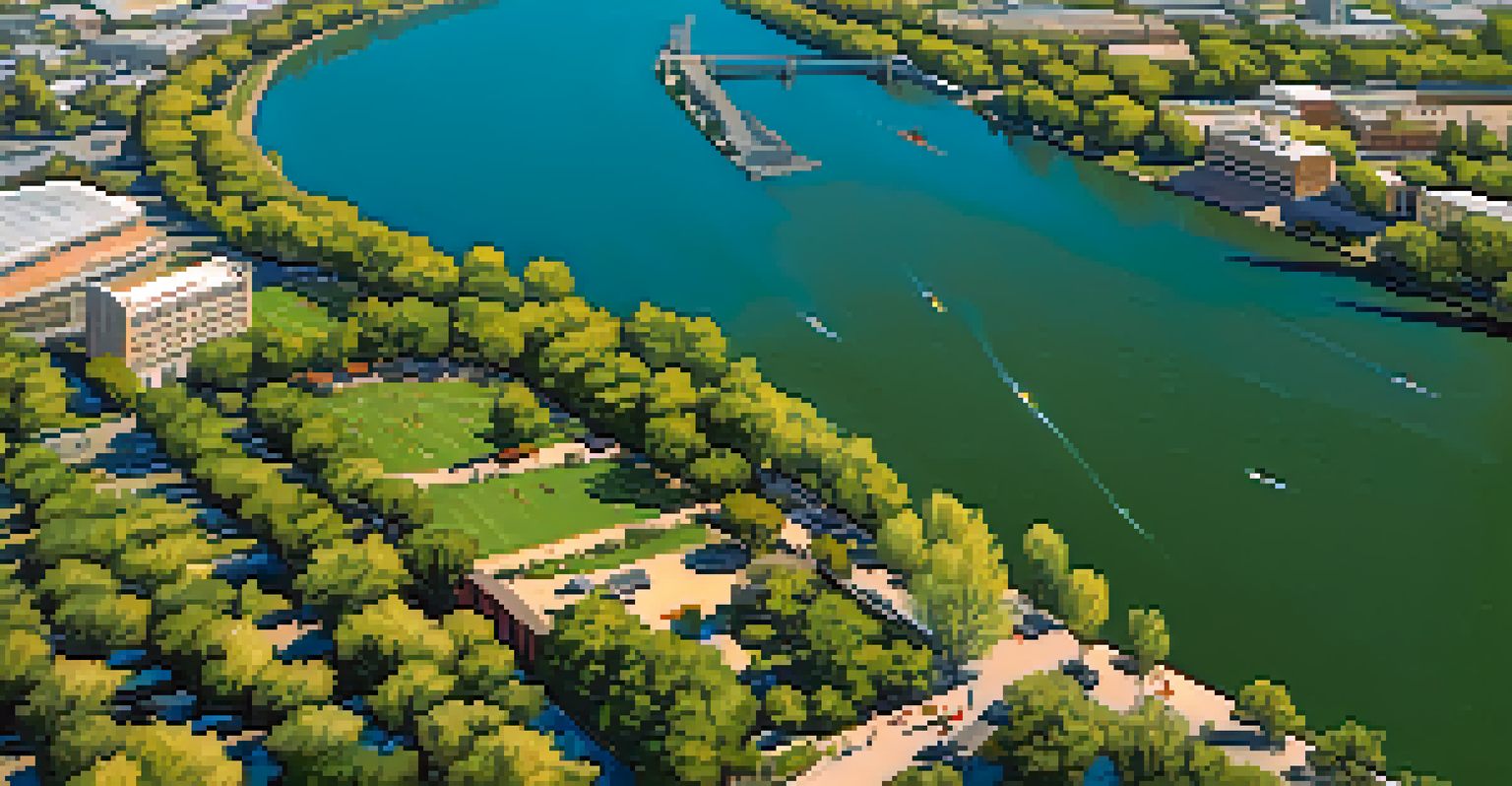How Sacramento's Historic Waterways Shaped Urban Growth

The Origins of Sacramento's Waterways and Their Importance
Sacramento, known for its vibrant culture and history, owes much of its growth to its historic waterways. The confluence of the Sacramento and American Rivers provided not only a crucial water source but also served as an essential transportation route. In the mid-1800s, these waterways attracted settlers and gold miners, establishing Sacramento as a key hub during the Gold Rush.
Rivers are the arteries of our planet; they are the lifeblood of our cities and civilizations.
The rivers acted as natural highways, facilitating trade and communication between burgeoning communities. This accessibility paved the way for businesses and industries to flourish, drawing people from all walks of life. The result was a diverse population that contributed to the city’s dynamic character and economic growth.
As Sacramento grew, the waterways became integral to its identity, influencing everything from urban planning to recreational activities. Parks and promenades along the riverbanks emerged as popular gathering spots, enhancing quality of life and fostering a sense of community among residents.
The Gold Rush: Catalyst for Urban Expansion
The Gold Rush in the 1840s and 1850s was a pivotal moment for Sacramento, transforming it from a modest outpost into a booming city. As fortune-seekers flocked to the region, the demand for supplies and services skyrocketed. The rivers played a central role in this transformation, allowing for the swift movement of goods and people, which was essential for economic growth.

With an influx of settlers, Sacramento quickly developed its infrastructure to support the booming population. Buildings, businesses, and transportation networks sprang up along the riverbanks, creating a bustling urban center. This rapid development set the stage for Sacramento's future growth, as the city adapted to the changing needs of its residents.
Waterways Drive Sacramento's Growth
The historic waterways of Sacramento were crucial in attracting settlers and facilitating trade during the Gold Rush, shaping the city's development.
However, the Gold Rush also brought challenges, including environmental impacts on the waterways. The need for resources and land led to significant alterations in the natural landscape, prompting discussions about sustainable growth and the preservation of the rivers as vital urban assets.
Transportation: Waterways as Lifelines for Commerce
Sacramento's historic waterways served as vital transportation routes that shaped the city's commerce. Steamboats navigated the rivers, linking Sacramento to other California ports and beyond. This aquatic transportation network allowed local merchants to expand their reach and facilitated the exchange of goods across the region.
Water is the driving force of all nature.
As the transportation industry thrived, so did the economy. Businesses capitalized on the river traffic, and new industries emerged, including shipbuilding and trade. The waterways were not only conduits for goods but also for ideas, as cultural exchanges flourished along with the economic activity.
Over time, the importance of waterways shifted with advancements in technology and transportation methods. As railroads began to dominate, the rivers still retained their significance, reminding us of their historical role in shaping Sacramento’s urban landscape and commercial identity.
Flooding Challenges and Urban Resilience
While the waterways brought prosperity, they also posed challenges, particularly in the form of flooding. Sacramento is situated in a floodplain, and heavy rains or snowmelt can lead to significant water overflow. The Great Flood of 1862, for instance, devastated the city and highlighted the need for better flood management solutions.
In response to these challenges, Sacramento invested in infrastructure improvements, including levees and flood control systems. These measures not only aimed to protect the city from future disasters but also influenced urban design and planning. The management of water resources became a critical aspect of Sacramento's growth strategy.
Flood Management Enhances Urban Resilience
Sacramento's investment in infrastructure improvements for flood control has been essential for protecting the city and influencing urban planning.
Today, the city continues to tackle flooding challenges while embracing its waterways as vital assets. Innovative approaches to urban planning, such as green infrastructure and sustainable development, reflect a commitment to resilience and environmental stewardship, ensuring that the rivers remain integral to Sacramento's identity.
Cultural Significance of Sacramento's Waterways
Beyond their practical uses, Sacramento's waterways hold cultural significance for the community. They are woven into the fabric of local history, representing a connection to the land and the people who have lived alongside them for generations. Festivals, events, and recreational activities celebrate this relationship, fostering a strong sense of place.
The rivers also serve as inspiration for artists, writers, and musicians, who capture their beauty and significance in various forms. This cultural richness enhances the city's appeal, attracting visitors and residents alike. The waterways thus play a dual role, contributing to both economic development and the cultural tapestry of the region.
Moreover, the ongoing appreciation for these waterways encourages community engagement and environmental awareness. Initiatives aimed at river clean-ups and conservation efforts reflect a collective commitment to preserving the natural beauty and health of Sacramento’s waterways for future generations.
Recreational Opportunities Along the Waterways
Sacramento's waterways are not just historical landmarks; they also offer a wealth of recreational opportunities for residents and visitors. From kayaking and paddleboarding to fishing and hiking, the rivers provide a natural playground that enhances the quality of life in the city. These activities foster a connection to nature and promote an active, outdoor lifestyle.
Parks and trails along the riverbanks have become popular destinations for families, joggers, and cyclists. Events such as riverfront concerts and farmers' markets bring the community together, creating vibrant social spaces that celebrate the local culture. The waterways serve as a backdrop for these gatherings, highlighting their importance in urban life.
Cultural and Recreational Hub
Sacramento's waterways serve as a cultural backdrop and provide numerous recreational opportunities, fostering community engagement and an active lifestyle.
Additionally, as public awareness of the benefits of outdoor recreation grows, Sacramento is focusing on enhancing access to its waterways. Investments in infrastructure, such as improved parks and bike paths, ensure that residents can fully enjoy and appreciate the beauty of their rivers while supporting a healthy, active community.
Future of Sacramento's Waterways and Urban Growth
Looking ahead, the future of Sacramento's historic waterways is intertwined with the city’s growth and development strategies. As urbanization continues, there is a pressing need to balance growth with sustainability. Ensuring the health of the waterways will be critical in maintaining the city’s ecological integrity and livability.
Innovative planning approaches will likely prioritize green spaces and water management solutions that protect the rivers while accommodating urban growth. Community involvement in these initiatives will be essential, as residents advocate for preserving the character and beauty of their waterways for future generations.

Ultimately, Sacramento's waterways are more than just geographical features; they are vital resources that have shaped the city’s history and will continue to influence its evolution. By honoring their legacy and embracing sustainable practices, Sacramento can ensure that its rivers remain a source of pride and prosperity for years to come.